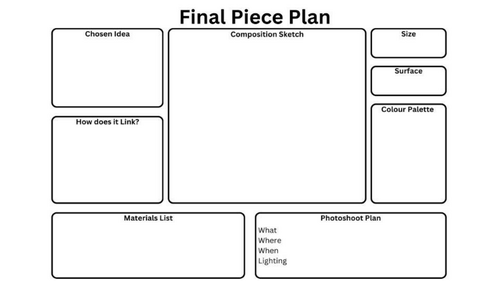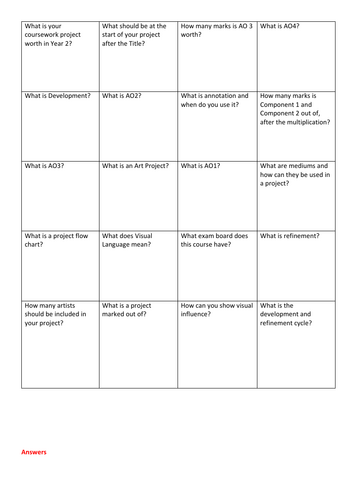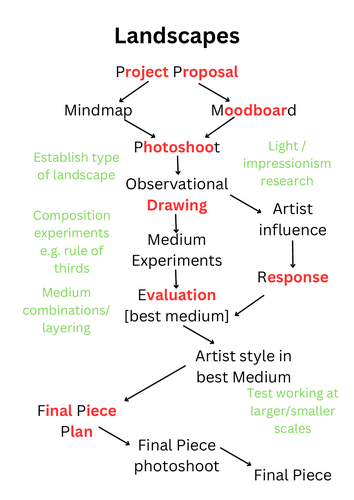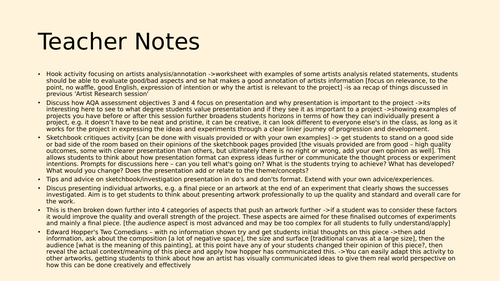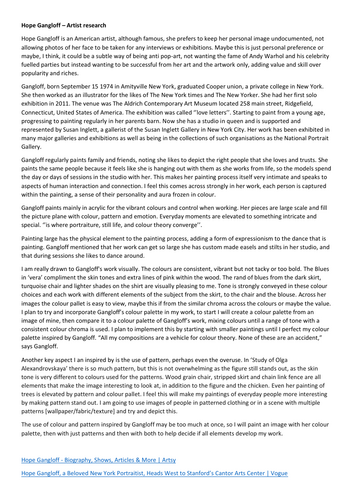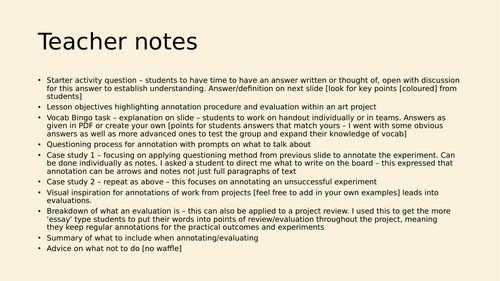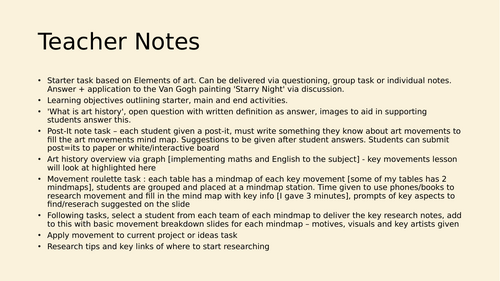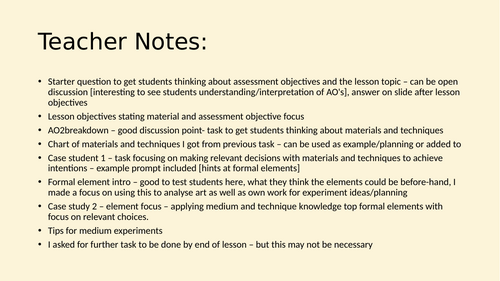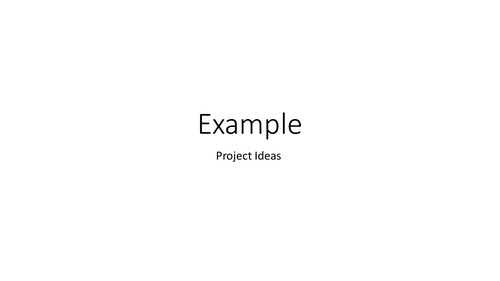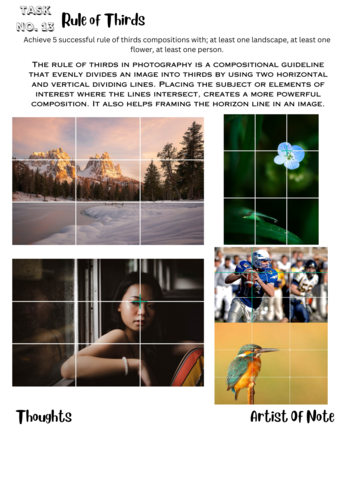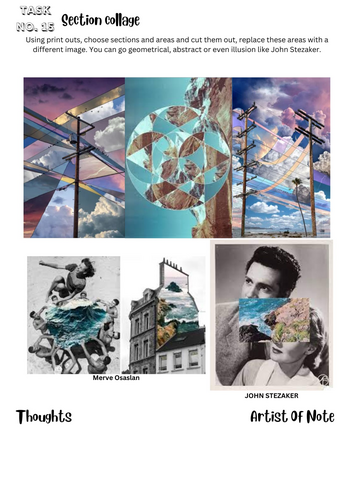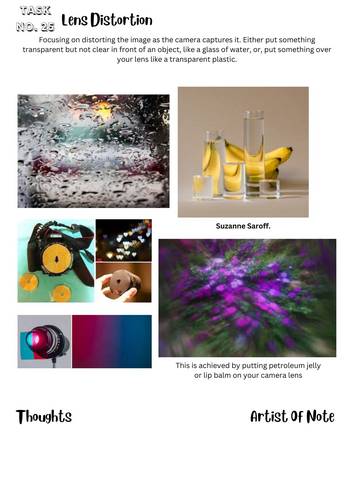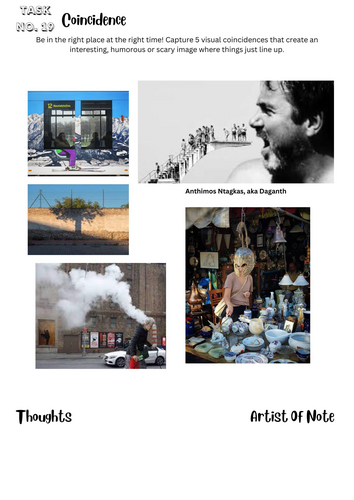27Uploads
2k+Views
615Downloads
All resources
Bundle

Recap lessons for Art and Design
8 full lessons with tasks and teacher notes.
The aim of these sessions is to recap key elements of creating creative projects in-line with AQA. Adaptable for GCSE and ALEVEL creative courses focused on fine art.
Lessons cover:
-medium experiments
art movements
annotation
artist research
presentation
development
assessment objectives
final piece and exam procedure
To be delivered to recap or introduce the topics.
Tasks and discussions included that appease creative lesson observations.
Bundle

Full summer Creative Subject activity Pack
Including:
40 tasks photography
40 tasks fine art
summer prep book
Adaptable for creative subjects at GCSE and Alevel
Guides students on research and creating practical work over summer

Recap lesson 8 - Exam Prep
Recap sessions aimed at Y1 September/January and Y2 September periods. Editable powerpoint and PDF of lesson with any relevant worksheets included.
For GCSE and/or ALevel creative subjects - fine art focus.
AQA exam board
This session informs and prepares students for fine art exam procedure. Delivered in preparation for a Y1 mock exam schedule where students make a final piece for their projects in exam conditions for good practice and preparation for formal exams.
Easily adaptable for different exam times/schedules.
Structure
starter activity
lesson objectives
assessment objectives breakdown
conditions of exam and mock adaptation
final piece planning
exam time planning

Recap lesson 7 - AO's and Final Piece
Recap sessions aimed at Y1 September/January and Y2 September periods. Editable powerpoint and PDF of lesson with any relevant worksheets included.
For GCSE and/or ALevel creative subjects - fine art focus.
AQA exam board
This session recaps the 4 AQA assessment objectives through research tasks, and also covers key knowledge of the course. In addition, it focuses on AO4 and introduces students to the prospects of a final piece with planning guides and inspiration.
This session aims for students to gain more clarity on the assessment objectives to improve implementation of them within their work.
Structure
starter task project bingo quiz
lesson objectives
breakdown of project assessment
carousel activity
marks and grade boundaries breakdown
AO4 and final piece
planning page inspiration
Final piece inspiration

Recap lesson 6 - Development and Refinement
Recap sessions aimed at Y1 September/January and Y2 September periods. Editable powerpoint and PDF of lesson with any relevant worksheets included.
For GCSE and/or ALevel creative subjects - fine art focus.
AQA exam board
This lesson encourages students to explore the concepts of development and refinement. As these are two key elements of the design process it is important for students to understand what they mean and how to effectively implement them in experiments and outcomes in accordance with assessment objectives.
Alot of students do not fully understand the importance of developing experiments and refining outcomes. AQA regularly see projects with ‘one and done’ responses. This lesson will allow students to explore what development and refinement are and apply the relevant questions to ask about their own work to create development within their projects.
Structure
starter task project flow chart based
lesson objectives
venn diagram activity
development breakdown
refinement breakdown
assessment objective application
idea tree diagram
circular development and refinement diagram
case study task
flow chart task
advice

Recap Lesson 5 - Presentation
Recap sessions aimed at Y1 September/January and Y2 September periods. Editable powerpoint and PDF of lesson with any relevant worksheets included.
For GCSE and/or ALevel creative subjects - fine art focus.
AQA exam board
Session aimed to show students the importance of presenting their work and how presentation aids in communicating their ideas and overall investigation, with a focus on visual language. Also expressing that there is no one correct way to present a sketchbook, with note on how students don’t have to be restricted to a sketchbook.
Additionally this session looks at presenting practical outcomes and individual pieces, from experiments to final outcomes, breaking down compositions, surfaces, scale and audience.
Structure
starter activity
lesson objectives
practical group discussion task
advice
presenting artwork
4 aspects of professional outcomes
discussion activity with real world application

Recap Lesson 4 - Artist Research
Recap sessions aimed at Y1 September/January and Y2 September periods. Editable powerpoint and PDF of lesson with any relevant worksheets included.
For GCSE and/or ALevel creative subjects - fine art focus.
AQA exam board
A favorite of mine. this session recaps all key aspects of artist research with useful and though provoking activities, As with annotation, I have found students can write too much or too little for their artist research. Here students will be shown what to focus on, relevance and intention.
The aim of the session is to support students with research: clarifying the what and how. Following this session students should be more confident and concise with research, pushing projects forward in progress and achievement.
Structure
-starter task quiz
Lesson objectives
the importance of research in an art project
research flow/process
what to research
2 case study activities
artist research activity
research presentation ideas
advice

Recap Lesson 3 - Annotation
Recap sessions aimed at Y1 September/January and Y2 September periods. Editable powerpoint and PDF of lesson with any relevant worksheets included.
For GCSE and/or ALevel creative subjects - fine art focus.
AQA exam board
This session goes over what AQA expect from annotation within a creative project. Exploring key vocab, structure, visual presentation and the importance of annotation, students will gain a deeper understanding of what is assessed and be able to apply this to their projects.
There is a spectrum where students write waffely essays or descriptive points for annotation, For AQA, annotation needs to only support the visual language shows through the journey of practical outcomes. This needs to express intent, reasoning and connections.
Structure
starter activity
lesson objectives
vocab bingo activity
key aspects of annotation
questioning flow
discussion activity 1
discussion activity 2
annotation visual inspiration
evaluation breakdown
advice

Recap Lesson 2 - Art Movements
Recap sessions aimed at Y1 September/January and Y2 September periods. Editable powerpoint and PDF of lesson with any relevant worksheets included.
For GCSE and/or ALevel creative subjects - fine art focus.
AQA exam board
Session introducing students to the Artworld through historic movements. Most students have little to no grasp of art history and so opening this world to them aims at inspiring creativity and possibility within their own projects.
Knowledge of art movements clarifies certain aspects of art and allows students to be exposed to these areas of research. To inspire creating work or progressing current projects it would aid students to know what to look for to find relevant : groups of artists, subject matter, style, mediums ans ways of working.
Structure
starter task question and discussion
lesson objective
opening discussion ‘what is art history?’
post-it activity
graph of art movements
movement roulette activity
key movement walkthrough
application of ideas
advice
key research links
Note: This session is easily adaptable and great for formal/practice teaching observations

Recap Lesson 1 - Medium Experiments
Recap sessions aimed at Y1 September/January and Y2 September periods. Editable powerpoint and PDF of lesson with any relevant worksheets included.
For GCSE and/or ALevel creative subjects - fine art focus.
AQA exam board
This short recap session covers the importance of exploration of mediums and techniques within a project. Through applying assessment objectives, medium idea generation, case study activities and a focus on the 6 key elements of art students should have a stronger understanding of art materials in relation to an art project.
The aim of this lesson is to allow students to explore mediums and techniques, establishing the difference between these two terms, to then be more confident in applying relevant materials through relevant processes to progress their own projects, pushing achievements in AO2 and overall assessment.
Structure
-starter task
-lesson objectives
-AO2 breakdown
-techniques vs mediums activity
-medium and technique table
-case study 1 activity
-elements of art intro
-case study 2 activity
-advice
-optional end of lesson task

Project Ideas Homework Task
Starting a project requires research and visual inspiration. This task guides students on presenting : titles, ideas, artists and contexts.
Instructions and example included for student access.
Addition of example of actual student responses for teachers - or for further examples for students.
This task allowed me to then discuss ideas with students before they began their projects, giving them more confidence and a stronger starting point.
PDF assignment and example as well as editable powerpoint included

Artist Catalogue
A catalogue of artists I have suggested throughout this past year for Component 1 and component 2.
Multiple processes, mediums, subjects and contexts included.
Each entry included artists name, as link for starting research and visual inspiration of the artists work.
PDF and editable powerpoint included so you can add to this catalogue.
I made this accessible to students to help with inspiration and motivation.

Project Starting Flow Charts
2 different basic ways to start a creative project presented through flowcharts that show one part to the next.
This aid should be used to help students struggling to start, present or progress in their projects.
Basic flow chart method used to map out or plan aspects of the project. Please note these are simplified steps that students should expand upon, not just use it as a page by page guide for sketchbooks.
I have found that using flow charts allows students to realize what they have achieved, organize their projects more efficiently and also plan key steps for a project.

Citing Artwork Poster
This visual poster details the key elements of citing artwork used by students in their projects. All artworks of influence used in projects should be correctly cited.
Applies to visual arts subjects and any artwork used as influence that is not the students own work.
Improves the quality and professional standard of projects.

Rule of Thirds Task Sheet
Task sheet with clear instruction and visual examples.
Aimed for photography students but can also be used with Art students.
Result of photoshoots, outcomes, artist notes, evaluation and understanding of new concept

Section Collage Task Sheet
Task sheet with clear instruction and visual examples.
Aimed for photography students but can also be used with Art students.
Result of photoshoots, outcomes, artist notes, evaluation and understanding of new concept

Lens Distortion Task Sheet
Task sheet with clear instruction and visual examples.
Aimed for photography students but can also be used with Art students.
Result of photoshoots, outcomes, artist notes, evaluation and understanding of new concept

Coincidence Task Sheet - Photography
Task sheet with clear instruction and visual examples.
Aimed for photography students but can also be used with Art students.
Result of photoshoots, outcomes, artist notes, evaluation and understanding of new concept

40 task Summer Workbook GCSE Photography
Intended for GCSE art/photography students. Can also be suggested for AS level students to practice and get inspired.
The aim of this booklet is to challenge students before their GCSE school year and prepare them for creating new art projects. With 40 tasks ranging from dada collage to golden ratio, this booklet aims to inspire, motivate and engage students in the arts.
By the end students will have:
a bank of 40+ artists/photographers they can be inspired by in later projects,
40+ photoshoots they can use or expand upon in their projects
40+visual outcomes
40+ examples of analysis and reflection
a stronger understanding of photography, evaluation, and some project ideas
The structure of the Booklet:
How to use the booklet info page
Advice pages including events, useful links, artist research tips, and project ideas tips.
Task pages with instruction and examples
Review task
Available:
PDF of tasks only, which can be used as individual tasks in lesson Can be given digitally or as a printed booklet

40 task Summer Workbook - GCSE Fine Art
Intended for GCSE art students.
The aim of this booklet is to challenge students before their GCSE school year and prepare them for creating new art projects. With 40 tasks ranging from collage to landscape art, this booklet aims to inspire, motivate and engage students in the arts.
By the end students will have:
a bank of 40+ artists they can be inspired by in later projects,
40+ artworks they can use or expand upon in their projects
40+ examples of analysis and reflection
a stronger understanding of art, evaluation, and some project ideas
The structure of the Booklet:
How to use the booklet info page
Advice pages including events, useful links, artist research tips, and project ideas tips.
Task pages with instruction and examples
Review task
Available:
PDF of tasks only, which can be used as individual tasks in lesson
PDF of** booklet print** version included with extra pages for work to be made on.



